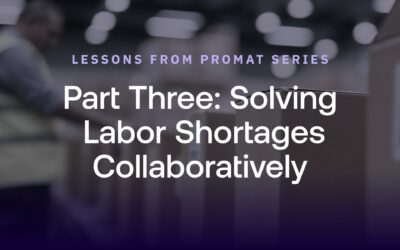Labor Shortages in the Warehouse? Here’s What Top Teams Are Doing

November 6, 2025 | By brendon Bielat
Warehouses are running full throttle on half the crew. Anyone who’s spent time in operations can feel it, the tension between what needs to get done and the people available to do it. Demand keeps rising, the labor pool keeps thinning, and no amount of hiring bonuses or pizza Fridays can bridge that gap for long. In my experience leading warehouse operations, the teams that succeed treat automation as a multiplier, not a replacement. They look for ways to make every person on the floor more effective, not just add more bodies.
The Labor Crunch and How Smart Operations Are Adapting
Hiring is harder than ever. Nearly 40% of warehouse operators say they don’t have enough workers to meet demand, and transportation isn’t far behind. When labor gets tight, it’s not just a scheduling headache, it’s a throughput problem. Missed picks today turn into late shipments tomorrow. Then the backlog starts to ripple across the network, creating the bullwhip effect that every supply chain manager dreads.
That’s why the smartest operators I’ve seen are changing their approach. Instead of chasing headcount, they’re investing in systems that help the people they already have perform better. A fleet of mobile robots that moves in sync with pickers, for example, helps stabilize output even when staffing dips. The combination of people and automation evens out the peaks and valleys that make warehouse life unpredictable.
Using Automation to Protect Service Levels
At one regional fulfillment center I visited, the leadership team was short a quarter of its staff but still managed to hit record on-time shipments after bringing in mobile robots. The headcount didn’t change much, but the workflow did. Robots handled long-distance transport while associates focused on picking accuracy and exceptions. It wasn’t about replacing people, it was about keeping them in flow. Service levels held steady, morale improved, and the site became one of the company’s top performers.
That’s the real benefit of automation: consistency. AMRs, when coordinated through platforms like Pyxis®, make performance predictable. They take on the repetitive motion that wears people out and slow work down. That balance keeps productivity high, accuracy tight, and burnout low.
Making Warehouse Work Sustainable
Early in my career, I underestimated how much physical fatigue drives turnover. Warehouse work takes a toll. Most pickers walk miles a day and handle heavy loads that add up fast. Injuries and fatigue aren’t just HR stats, they’re symptoms of a system under strain. Automation helps by taking the heavy travel off people’s plates so they can focus on what humans do best: decision-making, problem-solving, and quality.
The difference shows up fast. Teams that once ended shifts exhausted now finish with energy left to spare. They start contributing ideas on how to make the process even better. Morale improves. Retention follows.
A Smarter Way to Grow Talent
When the physical strain eases, people can grow. They take on roles that use their experience instead of their endurance. I’ve seen associates who started as pickers become trainers, quality leads, or automation specialists because the technology gave them time and headspace to learn. That’s the real return on investment, turning good employees into great ones who stay.
Why Collaboration Wins
As Harvard Business Review noted, when people and robots work side by side, performance improves across the board. Less fatigue. Less wasted movement. More focus on what matters. The best automation programs don’t replace people, they give them better tools. They help teams move in rhythm, combining human judgment with robotic precision.
This kind of collaboration also changes how companies scale. Instead of over-hiring for peak season, operators can flex automation output up or down. When volume slows, systems idle without layoffs. When it spikes, they ramp instantly. That flexibility turns volatility into stability.
Building a Workforce that Lasts
The real test isn’t whether automation replaces labor. It’s whether it creates workplaces where people want to stay. The goal is to make every role on the floor more rewarding, not redundant.
At Onward Robotics, our Meet Me® strategy, powered by Pyxis intelligence, is built around that principle. Workers meet robots at the right place and time, guided by simple visual cues and an interface that keeps them in control. The system eliminates wasted steps, improves accuracy, and helps teams perform at their best.
Every deployment reinforces the same truth: automation done right doesn’t replace people, it helps them perform at a higher level. It turns pressure into flow and helps build the kind of resilient, scalable workforce that modern fulfillment depends on.
Learn how Onward Robotics can help you build a more resilient, efficient, and scalable fulfillment operation with a human + robot workforce. Contact us to schedule a demo or speak with a solutions expert.


